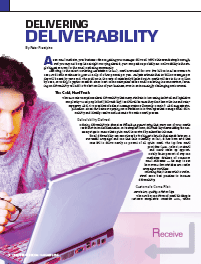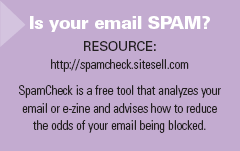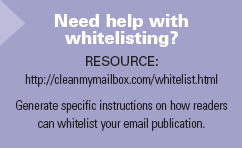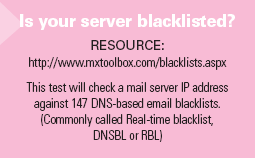Delivering Deliverability

As an email marketer, your business relies on getting your messages delivered. While this sounds simple enough, and you may not be up late at night worrying about it, your competitors probably are. Deliverability is the single biggest concern for the email marketing community.
 |
According to the Direct Marketing Association (DMA), email accounted for over $39 billion in sales revenue in 2004 and traffic continues to grow at a clip of 25-30 percent per year. Analysts estimate that 60 billion messages per day will be sent by year's end. The problem is, the costs of mistakenly blocked opt-in emails will rise to $419 million by 2008, according to Jupiter Research. Since most online enterprises utilize email marketing in some manner, focusing on deliverability will add to the bottom line of your business, even in an increasingly challenging environment. |
The Cold, Hard Truth
There are misconceptions about deliverability that many attribute to increasing technical and legislative complexity. "Most people find [deliverability] too difficult because they don't know the ins and outs," says Barry Abel, vice president of sales at Message Systems (formerly OmniTI). Abel suggests simplification. Smart marketers are paying more attention to technologies that manage email deliverability and identify, resolve and automate the entire email process.
Deliverability Defined:
Defining deliverability is almost as difficult as guaranteeing that every one of your emails reach their intended destination. In its simplest form, deliverability means taking the necessary steps to ensure that opt-in email is received by subscriber inboxes.
Email deliverability can sometimes be the biggest obstacle that stands between a successful campaign and one that fails miserably. In fact, it has been said that ISPs fail to deliver nearly 20 percent of all opt-in email. The top four email providers (AOL, Yahoo!, Hotmail and MSN) make up approximately 50-60 percent of any one marketer's database of consumer email addresses - it's easy to see how even a few mistakes can render campaigns worthless.
Knowing this, it is essential to understand some best practices to increase deliverability.
Customers Come First:
Permission, Quality, Relationships
The number one driver of email blocking is customer complaints. Consider AOL, where just one complaint per one thousand emails sent can identify you as a spammer, wreaking havoc on your email marketing efforts.
While spammers don't really care, the rest of the marketing community certainly does. Failure to receive explicit permission and confirmation from your recipients can mean the difference between sailing along unabated and wallowing in a mire of customer and ISP complaints. "It really comes down to permission," says Chip House, vice president of deliverability for Exact Target. "The makeup of the list and how it is captured makes the biggest difference.
Avoid complaints and you avoid most of the problems that result, namely fewer sales and conversions. Being upfront about what kind of content is contained in an email (informational product reviews, commentary or straight advertising) and notifying subscribers about the frequency that you intend to send these emails will result in less dissatisfaction and fewer complaints.
With permission granted, you can focus on content - the true driver of email marketing results. Even the best-designed and developed emails from premier copywriters can be blocked. As such, many email marketers routinely run their messages through a spam check before sending. The most reliable test is sent from the email server that will be sending your email.
If you use an email service provider (ESP), it may offer a spam check service to you. These tools enable email marketers to determine what may or may not be seen as spam in the virtual eyes of an ISP. The process, called content filtering, identifies common triggers of blocked emails such as overly promotional words and phrases. While the words free, discount or bargains may not definitively identify your content as spam, they may diminish the perceived quality of the content and thereby force your email to the marketing abyss often known as the junk folder.

While email marketers are responsible for overall deliverability, consumers are in control of their inboxes and are demanding greater accountability from the companies they receive messages from. As consumers find that there is no perfect solution for filtering spam emails, it's common that some emails may incorrectly be filtered. What's the solution? Companies need to encourage recipients to "whitelist" their emails.
Make it part of your name capture process. Have an "add to address book" strategy. Ask the subscriber to whitelist your messages by adding your email address to their address book. This will circumvent almost all filters at major ISPs and desktop mail clients.

Know Where You Stand
From time to time, even legitimate email marketers find themselves listed on an email blacklist. Blacklists are used by ISPs and inbox providers to find out whose emails should not be going through their systems. Marketers will usually become blacklisted because, at one time, the sender has done something worthy of some unwanted and negative attention. That may sound vague, but so is the process. Blacklists do not differentiate and that's a problem. For example, you may have just offered a product giveaway to generate signups and then started emailing your new subscribers.
Those subscribers may not actually want to hear from you - they may have just wanted to receive the free offer. Rather than simply unsubscribe from your list, many recipients will report your emails as spam, thus landing you on a blacklist. To make matters more complex, there are hundreds of blacklists and, once on them, there's no easy way to get off. This is why many website owners are turning to in-house managed email marketing solutions such as Message Systems' Ecelerity. Their technical solutions help handle IP relations for you.

Authentication and Accreditation
Many experts agree that the increasing demand for email authentication and the rise of sender accountability are the biggest challenges facing email marketers. "In order to rid the medium of spam and restore consumer trust, sender accountability will become a reality over the next 12-18 months," says Dave Lewis, vice president of alliances & market development at StrongMail Systems. "The major ISPs will require that senders both authenticate their email and have a reputation worthy of unimpeded access to their customers.
It is becoming essential to take steps to make sure that your program is compliant. Recipient authentication and sender accountability increasingly require a close and careful examination.
Email authentication helps prevent forged email and identifies senders that meet with the approval of ISPs and consumers. SPF, Sender ID and DomainKeys are various protocols that have gained support from major ISPs AOL, Hotmail/MSN and Yahoo. Reputable senders - those with few complaints and a solid reputation - become accredited by scoring systems. Companies such as Bonded Sender, Habeas and Goodmail Systems CertifiedEmail provide these systems. Being accredited increases the chances of high deliverability. All together, this improves the email equation for both senders and receivers.
Stable, Reliable Infrastructure
Mail transfer agent problems and an improper DNS setup are other serious challenges email marketers face. Unfortunately, those issues are also the most overlooked, except for the most serious practitioners.
Maintaining consistent service is critical for your business - customers expect it. Message Systems' email platform, Ecelerity, provides clients with the flexibility to adjust to their customers' changing requirements. "The goal is to provide a complete tool kit that supports everything and makes sure the email gets through," says Abel. What should be included in this tool kit? Ideally, says Abel, a turnkey solution will feature bounce processing, security, traffic shaping, single point management, logging, clustering, authentication standards, accreditation solutions and a high level of performance.
Investing in an email platform that offers these features will help companies improve their email deliverability and the results their marketing efforts generate. ■

Subscribe to Our Newsletter!
Latest in Marketing








